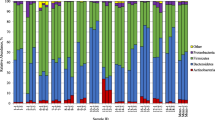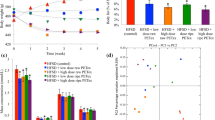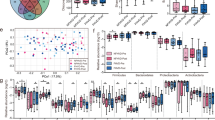Abstract
Evidence suggests that fermented foods and beverages made from fruits and vegetables benefit human health, including in the prevention of cardiovascular disease, cancer, diabetes and gastrointestinal disorders. However, there are few studies on the effects of fermented fruits and vegetables on intestinal microbiota. In this study, we investigated the changes in the composition of the intestinal microbial community after short-term treatment with a fermented beverage of Changbai Mountain fruit and vegetables (FB). Forty male ICR mice, weighing 17–19 g, were fed diets with different concentrations of the FB or distilled water for 15 days. 16S rDNA gene sequences were used to analyze the gut microbiota with the Illumina sequencing platform and a paired-end method. FB had no effect on weight gain, the adiposity index, or food intake in the treated mice compared with the control group. The cecal index was significantly higher in the FB-administered groups than in the control group. Firmicutes and Bacteroidetes were the dominant phyla in the mice ceca. The Firmicutes/Bacteroidetes ratio was reduced in the FB-administered mice, and proportions of the family Prevotellaceae, Bacteroidales_S24–7_group, family Bacteroidaceae, and genus Bacteroides increased, and these increases were correlated positively with intake of fermented beverage. The FB also altered the diversity of the cecal microbiota in the mice.

Graphical Abstract
Similar content being viewed by others
References
Shukla SD, Budden KF, Neal R, Hansbro PM (2017) Microbiome effects on immunity, health and disease in the lung. Clin Transl Immunol 6:e133. https://doi.org/10.1038/cti.2017.6
Human Microbiome Project C (2012) Structure, function and diversity of the healthy human microbiome. Nature 486:207–214. https://doi.org/10.1038/nature11234
De Filippo C, Cavalieri D, Di Paola M, Ramazzotti M, Poullet JB, Massart S, Collini S, Pieraccini G, Lionetti P (2010) Impact of diet in shaping gut microbiota revealed by a comparative study in children from Europe and rural Africa. Proc Natl Acad Sci USA 107:14691–14696. https://doi.org/10.1073/pnas.1005963107
Turnbaugh PJ, Ridaura VK, Faith JJ, Rey FE, Knight R, Gordon JI (2009) The effect of diet on the human gut microbiome: a metagenomic analysis in humanized gnotobiotic mice. Sci Transl Med 1:6ra14. https://doi.org/10.1126/scitranslmed.3000322
Motarjemi Y, Nout MJ (1996) Food fermentation: a safety and nutritional assessment. Joint FAO/WHO workshop on assessment of fermentation as a household Technology for Improving Food Safety. Bull World Health Organ 74:553–559
Li J, Stickel SL, Bouton-Verville H, Burgin KE, Yu X, Wong DK, Wagner TE, Wei Y (2008) Fermented noni exudate (fNE): a mediator between immune system and anti-tumor activity. Oncol Rep 20:1505–1509
Yang EJ, Kim SI, Park SY, Bang HY, Jeong JH, So JH, Rhee IK, Song KS (2012) Fermentation enhances the in vitro antioxidative effect of onion (Allium cepa) via an increase in quercetin content. Food Chem Toxicol 50:2042–2048. https://doi.org/10.1016/j.fct.2012.03.065
Lu M, Toshima Y, Wu XL, Zhang X, Cai YQ (2007) Inhibitory effects of vegetable and fruit ferment liquid on tumor growth in Hepatoma-22 inoculation model. Asia Pac J Clin Nutr 16(Suppl 1):443–446
Kedia G, Vazquez JA, Charalampopoulos D, Pandiella SS (2009) In vitro fermentation of oat bran obtained by debranning with a mixed culture of human fecal bacteria. Curr Microbiol 58:338–342. https://doi.org/10.1007/s00284-008-9335-1
Dethlefsen L, McFall-Ngai M, Relman DA (2007) An ecological and evolutionary perspective on human-microbe mutualism and disease. Nature 449:811–818. https://doi.org/10.1038/nature06245
Pinar A, Akyon Y, Alp A, Erguven S (2010) Adaptation of a sensitive DNA extraction method for detection of Entamoeba histolytica by real-time polymerase chain reaction. Mikrobiyoloji Bul 44:453–459
Magoc T, Salzberg SL (2011) FLASH: fast length adjustment of short reads to improve genome assemblies. Bioinformatics 27:2957–2963. https://doi.org/10.1093/bioinformatics/btr507
Caporaso JG, Kuczynski J, Stombaugh J, Bittinger K, Bushman FD, Costello EK, Fierer N, Pena AG, Goodrich JK, Gordon JI, Huttley GA, Kelley ST, Knights D, Koenig JE, Ley RE, Lozupone CA, McDonald D, Muegge BD, Pirrung M, Reeder J, Sevinsky JR, Turnbaugh PJ, Walters WA, Widmann J, Yatsunenko T, Zaneveld J, Knight R (2010) QIIME allows analysis of high-throughput community sequencing data. Nat Methods 7:335–336. https://doi.org/10.1038/nmeth.f.303
Edgar RC, Haas BJ, Clemente JC, Quince C, Knight R (2011) UCHIME improves sensitivity and speed of chimera detection. Bioinformatics 27:2194–2200. https://doi.org/10.1093/bioinformatics/btr381
Edgar RC (2013) UPARSE: highly accurate OTU sequences from microbial amplicon reads. Nat Methods 10:996–998. https://doi.org/10.1038/nmeth.2604
Otles S, Ozgoz S (2014) Health effects of dietary fiber. Acta Sci Pol Technol Aliment 13:191–202
Yang J, Bindels LB, Segura Munoz RR, Martinez I, Walter J, Ramer-Tait AE, Rose DJ (2016) Disparate metabolic responses in mice fed a high-fat diet supplemented with maize-derived non-digestible feruloylated oligo- and polysaccharides are linked to changes in the gut microbiota. PLoS One 11:e0146144. https://doi.org/10.1371/journal.pone.0146144
Li B, Zhang X, Guo F, Wu W, Zhang T (2013) Characterization of tetracycline resistant bacterial community in saline activated sludge using batch stress incubation with high-throughput sequencing analysis. Water Res 47:4207–4216. https://doi.org/10.1016/j.watres.2013.04.021
Blatchford P, Stoklosinski H, Walton G, Swann J, Gibson G, Gearry R, Ansell J (2015) Kiwifruit fermentation drives positive gut microbial and metabolic changes irrespective of initial microbiota composition. Bioact Carbohydr Dietary Fibre 6:37–45. https://doi.org/10.1016/j.bcdf.2015.07.001
Wang H, Hong T, Li N, Zang B, Wu X (2018) Soluble dietary fiber improves energy homeostasis in obese mice by remodeling the gut microbiota. Biochem Biophys Res Commun 498:146–151. https://doi.org/10.1016/j.bbrc.2018.02.017
Murphy EF, Cotter PD, Healy S, Marques TM, O'Sullivan O, Fouhy F, Clarke SF, O'Toole PW, Quigley EM, Stanton C, Ross PR, O'Doherty RM, Shanahan F (2010) Composition and energy harvesting capacity of the gut microbiota: relationship to diet, obesity and time in mouse models. Gut 59:1635–1642. https://doi.org/10.1136/gut.2010.215665
Turnbaugh PJ, Ley RE, Mahowald MA, Magrini V, Mardis ER, Gordon JI (2006) An obesity-associated gut microbiome with increased capacity for energy harvest. Nature 444:1027–1031. https://doi.org/10.1038/nature05414
Chen G, Xie M, Wan P, Chen D, Dai Z, Ye H, Hu B, Zeng X (2018) Fuzhuan brick tea polysaccharides attenuate metabolic syndrome in high-fat diet induced mice in association with modulation in the gut microbiota. J Agric Food Chem 66:2783–2795. https://doi.org/10.1021/acs.jafc.8b00296
Vendrame S, Guglielmetti S, Riso P, Arioli S, Klimis-Zacas D, Porrini M (2011) Six-week consumption of a wild blueberry powder drink increases bifidobacteria in the human gut. J Agric Food Chem 59:12815–12820. https://doi.org/10.1021/jf2028686
Ivarsson E, Roos S, Liu HY, Lindberg JE (2014) Fermentable non-starch polysaccharides increases the abundance of Bacteroides-Prevotella-Porphyromonas in ileal microbial community of growing pigs. Animal 8:1777–1787. https://doi.org/10.1017/s1751731114001827
Ormerod KL, Wood DL, Lachner N, Gellatly SL, Daly JN, Parsons JD, Dal'Molin CG, Palfreyman RW, Nielsen LK, Cooper MA, Morrison M, Hansbro PM, Hugenholtz P (2016) Genomic characterization of the uncultured Bacteroidales family S24-7 inhabiting the guts of homeothermic animals. Microbiome 4:36. https://doi.org/10.1186/s40168-016-0181-2
Li J, Wu T, Li N, Wang X, Chen G, Lyu X (2019) Bilberry anthocyanin extract promotes intestinal barrier function and inhibits digestive enzyme activity by regulating the gut microbiota in aging rats. Food Funct 10:333–343. https://doi.org/10.1039/c8fo01962b
Zhao L, Zhang Q, Ma W, Tian F, Shen H, Zhou M (2017) A combination of quercetin and resveratrol reduces obesity in high-fat diet-fed rats by modulation of gut microbiota. Food Funct 8:4644–4656. https://doi.org/10.1039/c7fo01383c
Salyers AA, Vercellotti JR, West SE, Wilkins TD (1977) Fermentation of mucin and plant polysaccharides by strains of Bacteroides from the human colon. Appl Environ Microbiol 33:319–322
Liu Q, Cao X, Zhuang X, Han W, Guo W, Xiong J, Zhang X (2017) Rice bran polysaccharides and oligosaccharides modified by Grifola frondosa fermentation: antioxidant activities and effects on the production of NO. Food Chem 223:49–53. https://doi.org/10.1016/j.foodchem.2016.12.018
Rogier R, Evans-Marin H, Manasson J, van der Kraan PM, Walgreen B, Helsen MM, van den Bersselaar LA, van de Loo FA, van Lent PL, Abramson SB, van den Berg WB, Koenders MI, Scher JU, Abdollahi-Roodsaz S (2017) Alteration of the intestinal microbiome characterizes preclinical inflammatory arthritis in mice and its modulation attenuates established arthritis. Sci Rep 7:15613. https://doi.org/10.1038/s41598-017-15802-x
Acknowledgements
This work was supported by Jilin Provincial Science and Technology Department (No.20180201050NY) and Jilin Aodong Jiaosu Technology Co., Ltd. (Study on the Biological Function of Aodong Jiaosu (Fermented Liquid of Changbai Mountain Plant)).
Author information
Authors and Affiliations
Corresponding author
Ethics declarations
Conflict of Interest
The authors declare no conflict of interest.
Additional information
Publisher’s Note
Springer Nature remains neutral with regard to jurisdictional claims in published maps and institutional affiliations.
Rights and permissions
About this article
Cite this article
Wang, Y., Yu, M., Shi, Y. et al. Effects of a Fermented Beverage of Changbai Mountain Fruit and Vegetables on the Composition of Gut Microbiota in Mice. Plant Foods Hum Nutr 74, 468–473 (2019). https://doi.org/10.1007/s11130-019-00761-7
Published:
Issue Date:
DOI: https://doi.org/10.1007/s11130-019-00761-7




